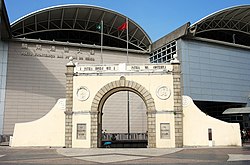
Back بورتاس دو سيركو ARZ Portas do Cerco French ボーダーゲート Japanese Portas do Cerco NB Portas do Cerco Portuguese 關閘 Chinese 關閘 ZH-YUE
| Portas do Cerco | |||||||||||||
|---|---|---|---|---|---|---|---|---|---|---|---|---|---|
 The Portas do Cerco in 2016 | |||||||||||||
| Chinese name | |||||||||||||
| Traditional Chinese | 關閘 | ||||||||||||
| Simplified Chinese | 关闸 | ||||||||||||
| Literal meaning | siege gate | ||||||||||||
| |||||||||||||
| Portuguese name | |||||||||||||
| Portuguese | Portas do Cerco | ||||||||||||
The Portas do Cerco is an area in Nossa Senhora de Fátima, Macau, China. Located on the northern tip of the Macau Peninsula, it is known by the Barrier Gate separating Macau from mainland China. The Portuguese built the gate in 1849 to replace a crumbling wall that the Chinese erected during the Ming dynasty in 1573.[1][2] The Chinese built a garrisoned wall to control the flow of people and goods.[3] It was the site of the Passaleão incident, a clash between the Qing dynasty and the Kingdom of Portugal in 1849 over the death of Macau's governor Ferreira do Amaral. Led by Colonel Mesquita, Portugal won the small battle which led to the extension of Macau's border northwards.[4] At the limit of said expansion, the Portas do Cerco was built with the inscription "A pátria honrai, que a pátria vos contempla" (Portuguese for "Honor your fatherland, for your fatherland looks over you") on the façade on its inner arch in 1849. The Barrier Gate served as a de facto boundary, but the precise limits of Macau's border has never been formally demarcated.[5]
Macau, now a special administrative region of China, still has an official border with Zhuhai in mainland China a few meters behind the old barrier gate. The new Posto Fronteiriço das Portas do Cerco (Barrier Gate Border Post) was opened on 15 January 2004.
- ^ Fodor, Eugene; Fisher, Robert C. (1962). Fodor's Japan and East Asia. p. 512.
- ^ Garrett, Richard J. (2010). The Defences of Macau: Forts, Ships and Weapons Over 450 Years. Hong Kong: Hong Kong University Press. pp. 18–19. ISBN 9888028499.
- ^ Mendes, Carmen Amado (2013). Portugal, China and the Macau Negotiations, 1986–1999. Hong Kong University Press. p. 10. ISBN 9789888139002.
- ^ Ride, Lindsay; Ride, May; Wordie, Jason (1999). The Voices of Macao Stones: The Nanjing Massacre Witnessed by American and British Nationals. Hong Kong University Press. pp. 49, 85. ISBN 978-962-209-487-1.
- ^ Breitung, Werner (2013). "Macau in the eyes of a border scholar". The Newsletter. No. 64. p. 25. International Institute for Asian Studies.